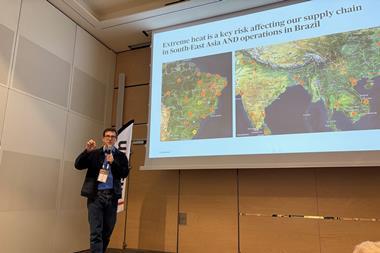In the past few years, there have been numerous examples of international companies which have been the victims of failure to manage risk, but also of organisations which have distinguished themselves by the excellence of their results and their innovative management practices. The latter turn the concept of global risk management from simply a theoretical notion into a veritable operational strategy.
While it may no longer be necessary to show the central role that risk management plays in the reputation or financial results of public and private organisations, it is interesting to look at the mechanisms of evolution, through which risk management success is achieved. We believe that the French Post Office is a striking example of how far an organisation has come in the past 10 years. The implementation of efficient risk management for all the sectors of the La Poste Group's activities constitutes, without a doubt, one of the cornerstones of its evolution and success. To reach this level of effectiveness, the decision makers of La Poste took into account the following two parameters:
- the behavioural sphere of risk management (the changing and abstract field that is the risk culture of a company, its orientation and its environment)
- the organisational sphere of risk management (action processes, systems of interaction with the rest of the organisation, and the actual analysis and processing methods).
If the organisational sphere of risk management constitutes the structure which allows for the realisation of a strategy, it is the behavioural sphere that is the source of all the energies necessary for its implementation.
This behavioural sphere, - a mixture of an organisation's environment and what is commonly called its risk culture - is too often taken for granted by decision makers and managers, to the point of seeing it as unimportant. However, the key to success lies in achieving the right balance between the objectives fixed by the decision makers and the manner in which other members of the staff position themselves in relation to the risks. La Poste has been going to great lengths to make the visions of the decision makers, the risk managers, and those in charge of the operational aspects coincide.
The objective is to make the risk culture the heart of both collective and individual conscience in the daily exercise of activities. Putting the accent on risk culture therefore means concentrating one's thoughts and strategies around human beings. La Poste has started from the belief that organisations which evolve are those that know how to be tuned in to their workforce, to channel energies to reach a common goal of creating long-term value.
La Poste bases its global risk management strategy on the premise that it is essential, whatever the sector of activity involved, to possess a strong risk culture in order to set up the structures that enable effective management of the unforeseen events, dangers and opportunities which arise from a perpetually changing environment. In order to avoid the numerous pitfalls that exist, Group La Poste has founded its approach to risk management culture around four major axes, representing the pillars of its short, medium and long term actions. These are:
- leadership and strategic innovation
- making employees aware of their responsibilities, motivation and satisfaction
- communication, sharing and apprenticeship
- structure and methods.
These are more vectors of organisational dynamism than simple attributes: one cannot help but notice that they represent the operational levers of risk management through the culture.
Leadership and innovation
The first pillar of Group La Poste's global risk management strategy - leadership and strategic innovation - refers to values held within the group as well as to its mission and its objectives.
This attribute of the group's strategy is based on the culture shared by all employees, where everyone has a precise idea of the orientation they should adopt towards the ultimate goal of satisfying the public's service demands. The example is set at the summit of the hierarchy and broadcast to the perimeter of the organisation. If the culture is a collective construction, the leaders - decision makers and managers of Group La Poste - must shape the risk culture by setting an example for the whole of the organisation. All companies - and none more so than La Poste - evolve in a dynamic environment where productive structures and those involved interact ceaselessly. Already the launching of the Postal Credit Establishment and the necessary application of market rules and norms have influenced the strategies and the risk management practices of the whole group.
Awareness of responsibilities, motivation and satisfaction
The second pillar relates to the capacity an organisation has to make all the workers that make up the company aware of their responsibilities.
Through a large 'Management's awareness of responsibility' project launched in 2003, La Poste sought to reinforce its policy of heightened awareness among all its workers in order to be able to guide employees in attaining their objectives. Today, each manager knows and understand his/her individual objectives and responsibilities. To sum up, everyone is conscious that he or she is pursuing objectives that are integrated with those of the organisation and aim at attaining common goals.
Based on the success of establishing this moral contract between La Poste and its workers, the dynamics of positive attitudes and good practices are under way. La Poste wants to perpetrate a harmonious culture where particular interests invariably meet the common interest.
Communication, sharing and apprenticeship
This third pillar of the group's strategy denotes the capacity of La Poste to promote and develop the skills of all of its collaborators around a major challenge - global risk management.
To carry out this task successfully and to generate the 'virtuous circle' around risk communication, Group La Poste's management have developed interaction with the different group projects - The Risk and Insurance Service, the Cap Mail Quality 2007 project, and the Establishment of Postal Credit (loan) 2005 project. This enables clear definition of the problems, improvement in the quality and quantity of information, and a combination of planning and implementation to reduce the time necessary to conceive and execute the risk management policies. The principal advantages of this kind of approach include assuring the dynamic of the process, guaranteeing the acceptance of the project, relying on experience and collective wisdom, and developing coalitions. For Gilbert Brat, chief risk officer, the findings are simple: "You have to organise the risk culture in such a way as to bring people to exchange and share the same value references".
Structure and methods
The fourth and last pillar, structure and methods, reflects the Group La Poste's capacity to evaluate the risks, measure them and take the necessary steps to conceive and deploy risk management measures.
Since 1992, the date that the risk and assurances service was created, the part devoted to risk management has been increasing. The year 2000
constituted a significant milestone when La Poste initiated its policy of global risk management.
It then became urgent to create an infrastructure able to respond to problems of identification, evaluation and dealing with risks. The creation of a global risk management unit within the group's legal and insurances department, the setting up of a risk management team within the Cap Quality Mail 2007 project, the creation of a risks for the establishment of postal credit department are all the materialisation of a dynamic started in the last four years. By relying on the centralised structure (the risk and insurances services), La Poste promotes today the sharing of information between the different risk management poles to obtain cross fertilisation in terms of methods and tools.
Under control
The organisation is under control! This assertion often overshadows the complexity and the expense of the efforts that are necessary for the implementation of a global risk management strategy. If La Poste is conscious of the scope of work to be done and the complexity of the task that awaits it, it is no less true that the implementation of a uniform and dynamic risk culture constitutes the key to success.
The tasks needed to produce and reinforce this culture remain difficult to implement, costly and a long-term job. Managing culture is not easier than managing the numbers; indeed the reverse is true. Working on the risk culture represents more than a simple company project, it is a real challenge.
Julien Morel is mail risk manager and Cyril Vegni is projects coordinator, La Poste, E-mail: cyril.vegni-prestataire@laposte.fr






























